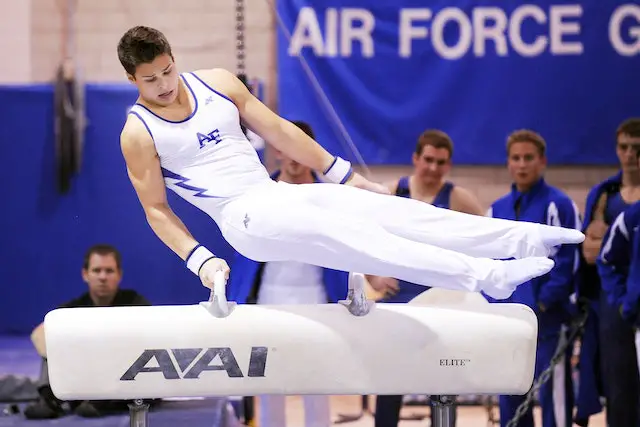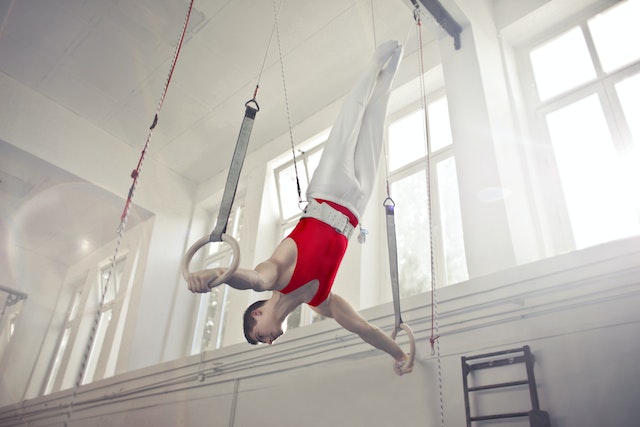Ballet emphasizes technique, poise, and storytelling through dance performances. Gymnastics focuses on strength, agility, balance as well as acrobatics to perform a variety of routines.
What is gymnastics?
(Photo by Pixabay)

Gymnastics is a sport that involves performing various exercises and routines on different apparatus such as balance beams, uneven bars, parallel bars, vaults, and rings. Gymnasts must have exceptional strength, flexibility, coordination, agility and control to execute their movements with precision and grace.
The origins of gymnastics can be traced back to ancient Greece where it was used for military training purposes. Later on, it evolved into a competitive sport that became an Olympic event in 1896. Today there are several disciplines within the realm of gymnastics including artistic gymnastics which focuses on floor exercises and apparatus events like the vault or beam; rhythmic gymnastics which combines dance with equipment work like hoops or ribbons; trampoline which involves acrobatic jumps on a bouncy surface; tumbling which features athletic flips and twists along mats; among others.
Gymnastics is not only physically demanding but also requires intense mental focus and concentration. Gymnasts spend countless hours perfecting their skills through practice sessions filled with drills aimed at building strength while refining technique. Despite its challenges, many people find joy in practicing this dynamic sport – whether professionally or recreationally!
What is ballet?
(Photo by Nihal Demirci Erenay on Unsplash )

Ballet is a highly technical form of dance that originated in the Italian Renaissance courts of the 15th century. It gradually evolved through France and Russia to become one of the most popular forms of dance today.
Ballet dancers use precise and graceful movements, often on tip-toe, to convey emotion and tell stories on stage. They must have incredible flexibility, strength, balance, coordination and control over their bodies.
Ballet performances are usually accompanied by classical music and elaborate costumes. The sets can be very simple or grandiose depending on the story being told.
There are three main types of ballet: classical ballet, neoclassical ballet and contemporary ballet. Classical ballet focuses on traditional techniques while neoclassical combines traditional moves with modern twists. Contemporary ballet is more experimental in nature.
Some famous ballerinas include Anna Pavlova, Misty Copeland, Natalia Makarova and Darcey Bussell. Ballet continues to inspire people all over the world with its beauty and gracefulness.
Gymnastics Vs. Ballet – Key differences
Gymnastics and ballet are both beautiful forms of movement that require a lot of physical skill and dedication. While they may appear similar to the untrained eye, there are some key differences between these two disciplines.
One major difference is the way in which movements are executed. In gymnastics, performers focus on power, strength, and speed to execute complex acrobatic maneuvers with precision and control. Ballet dancers, on the other hand, prioritize gracefulness and fluidity in their movements.
Another significant variation is the type of attire worn by athletes in each discipline. Gymnasts usually wear leotards or unitards that allow for maximum range of motion while also providing support during high-impact moves. Ballerinas typically wear tutus or flowing dresses that enhance their elegant movements.
The training methods used by gymnasts vs ballerinas also differ significantly. Gymnasts tend to focus on building muscle mass through weight training exercises such as squats and deadlifts whereas ballet dancers work hard at perfecting their form through repetitive practice techniques.
Both gymnastics and ballet require intense dedication from performers who must train rigorously for years before achieving success within these respective fields.
Can a ballerina be a gymnast?
Many people wonder if a ballerina can also be a gymnast, and the answer is yes! While both sports have their unique characteristics, there are similarities in strength, flexibility, and technique that make it possible for someone to excel in both.
Ballet dancers often have incredible flexibility and balance due to years of training. Gymnasts also require these same skills but may focus more on explosive power rather than fluid movements. However, the body control required for ballet translates well into gymnastics routines.
It’s important to note that while some skills such as leaps and turns may transfer easily between the two sports, others like tumbling passes require different techniques. Therefore, individuals who wish to pursue both must train diligently in each discipline separately.
In fact, several famous athletes including former Olympic gymnast Nastia Liukin began their careers studying ballet before transitioning into gymnastics. So whether you’re interested in dance or acrobatics – or both – don’t let anyone tell you that you can’t do it all!
What are the 3 different types of ballet?
Ballet is often considered one of the most graceful and beautiful forms of dance. It requires a high level of skill, strength, and endurance which can take years to master. There are three different types or styles of ballet – classical ballet, neoclassical ballet, and contemporary ballet.
Classical Ballet is the oldest form of ballet that originated in Italy during the Renaissance period. Classical Ballet follows specific rules when it comes to movements and technique. It typically involves pointe work where ballerinas wear shoes with reinforced toes to support their body weight while dancing on their tiptoes.
Neoclassical Ballet emerged in response to the strict structure of classical ballet. This style combines traditional elements with modern techniques allowing for more freedom in movement expression without sacrificing gracefulness.
Contemporary Ballet is a fusion between classical and modern dance styles allowing for even greater flexibility in movement interpretation than neoclassical ballet does. Contemporary Ballet has no set rules as its main goal is self-expression through movement.
Each type or style of ballet offers unique challenges requiring specific skills from dancers who choose to master them all throughout their careers.
What is the rhythmic gymnastics?
Rhythmic gymnastics is a form of gymnastics that combines elements of dance, acrobatics, and performance art. It originated in Eastern Europe and was first introduced at the Olympics in 1984.
In rhythmic gymnastics, athletes perform routines to music while using various apparatus such as ribbon, hoop, ball, clubs or rope. The routines are judged based on their difficulty level, execution precision and artistic expression.
What sets rhythmic gymnastics apart from traditional artistic gymnastics is its focus on gracefulness and fluidity of movement rather than raw strength. Athletes must have exceptional flexibility, balance and coordination to execute complex maneuvers with ease.
Rhythmic gymnasts also incorporate unique body movements such as contortions and balances into their routines which require incredible control over their bodies.
The sport has gained popularity worldwide due to its beauty and elegance. Watching a skilled rhythmic gymnast effortlessly move across the floor with an apparatus can be mesmerizing for spectators.
Who is the greatest ballet dancer of all time?
When it comes to ballet, there have been numerous legendary dancers who’ve graced the stage. It’s difficult to choose just one as the greatest of all time, but there are certainly some who stand out.
One such dancer is Rudolf Nureyev. He was a Soviet-born dancer and choreographer who rose to fame in the 1960s. He was known for his incredible technical skill and his captivating stage presence.
Another iconic ballet dancer is Mikhail Baryshnikov. Born in Latvia, he defected from the Soviet Union in 1974 and went on to become one of the most famous dancers of all time. His athleticism and artistry were unparalleled, and he remains an inspiration to many aspiring dancers today.
Of course, we can’t forget about Anna Pavlova, whose name has become synonymous with classical ballet. She was born in Russia in 1881 and became a principal dancer with the Imperial Ballet at just 18 years old. Her interpretation of “The Dying Swan” is still considered one of her most iconic performances.
Other notable names include Margot Fonteyn, George Balanchine, and Misty Copeland – each unique in their own right but all contributing significantly to this beautiful art form over the years.
Who is the greatest gymnast of all time?
When it comes to determining the greatest gymnast of all time, there are many different opinions and arguments. Some people might argue for Nadia Comaneci, who was the first gymnast to score a perfect 10 at the Olympics. Others might argue for Simone Biles, who has won an astonishing 30 Olympic and World Championship medals.
One thing is for sure: both Comaneci and Biles have had an immense impact on their sport. Comaneci’s flawless routines in the 1970s helped put gymnastics on the map as a serious sport. Meanwhile, Biles’ unparalleled athleticism has pushed the boundaries of what is possible in women’s gymnastics today.
Other names that often come up in discussions of great gymnasts include Larisa Latynina (who held the record for most Olympic medals until Biles broke it), Olga Korbut (who popularized acrobatic moves like flips on the balance beam), and Mary Lou Retton (who became America’s sweetheart with her gold medal performance at Los Angeles 1984).
Ultimately, deciding who is truly “the greatest” is subjective and depends on personal preferences and criteria. However, one thing is certain: these athletes have all contributed significantly to making gymnastics into one of the most exciting sports around today.
Featured Image By – Photo by Andrea Piacquadio









